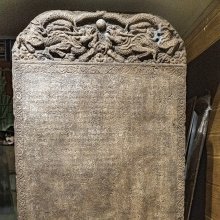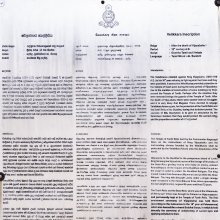Pom, Pōṃ, Poṃ, Poṉ, Pōm, Pōṉ: 6 definitions
Introduction:
Pom means something in Marathi, Hindi, biology, Tamil. If you want to know the exact meaning, history, etymology or English translation of this term then check out the descriptions on this page. Add your comment or reference to a book if you want to contribute to this summary article.
Images (photo gallery)
Biology (plants and animals)
Source: Google Books: CRC World Dictionary (Regional names)1) Pom in Central Africa is the name of a plant defined with Allanblackia floribunda in various botanical sources. This page contains potential references in Ayurveda, modern medicine, and other folk traditions or local practices It has the synonym Allanblackia parviflora A. Chev. (among others).
2) Pom in Central America is also identified with Bursera simaruba It has the synonym Burseria gummifera (L.) L. (etc.).
Example references for further research on medicinal uses or toxicity (see latin names for full list):
· Monographiae Phanerogamarum (1883)
· Botanische Jahrbücher für Systematik, Pflanzengeschichte und Pflanzengeographie (1881)
· North American Flora (1911)
· Journal of the Linnean Society, Botany (1867)
· Species Plantarum (1762)
· Die Natürlichen Pflanzenfamilien ed. 2 (1931)
If you are looking for specific details regarding Pom, for example health benefits, extract dosage, pregnancy safety, side effects, diet and recipes, chemical composition, have a look at these references.

This sections includes definitions from the five kingdoms of living things: Animals, Plants, Fungi, Protists and Monera. It will include both the official binomial nomenclature (scientific names usually in Latin) as well as regional spellings and variants.
Languages of India and abroad
Marathi-English dictionary
Source: DDSA: The Molesworth Marathi and English Dictionarypōṃ (पों).—m A lump of dung,--the mass as voided at once.
--- OR ---
pōṃ (पों).—ad Imit. of the sound of pipes, fifes &c.
Source: DDSA: The Aryabhusan school dictionary, Marathi-Englishpōṃ (पों).—m A lump of dung. ad Imit. of the sound of pipes, fifes &c.
Marathi is an Indo-European language having over 70 million native speakers people in (predominantly) Maharashtra India. Marathi, like many other Indo-Aryan languages, evolved from early forms of Prakrit, which itself is a subset of Sanskrit, one of the most ancient languages of the world.
Hindi dictionary
Source: DDSA: A practical Hindi-English dictionaryPoṃ (पों):—(nf) the sound of a horn; -[poṃ] recurrent sound as produced by a horn.
...
Kannada-English dictionary
Source: Alar: Kannada-English corpusPoṃ (ಪೊಂ):—[noun] (in comp.) gold.
--- OR ---
Poṃ (ಪೊಂ):—[noun] (in comp.) gold.
--- OR ---
Pon (ಪೊನ್):—[noun] = ಪೊನ್ನು [ponnu].
Kannada is a Dravidian language (as opposed to the Indo-European language family) mainly spoken in the southwestern region of India.
Tamil dictionary
Source: DDSA: University of Madras: Tamil LexiconPoṉ (பொன்) noun [Telugu: poṉṉu, Kanarese, Malayalam: poṉ.]
1. Gold, of which there are four kinds, viz., cātarūpam, kiḷicciṟai, āṭakam, cāmpūṉatam; சாதரூபம், கிளிச்சிறை, ஆடகம், சாம்பூனதம் என நான்கு வகைப்பட்ட தங்கம். பொன்னுந் துகிரு முத்தும் [satharupam, kilichirai, adagam, sambunatham ena nanku vagaippatta thangam. ponnun thugiru muthum] (புறநானூறு [purananuru] 218).
2. Metal; உலோகம். (பிங்கலகண்டு) செம்பொன், வெண்பொன், கரும்பொன். [ulogam. (pingalagandu) sembon, venpon, karumbon.]
3. Iron; இரும்பு. தூண்டிற் பொன்மீன் விழுங்கி யற்று [irumbu. thundir ponmin vizhungi yarru] (திருக்குறள் [thirukkural], 931).
4. Wealth; செல்வம். பொன்னுடைய ரேனும் புகழுடைய ரேனும் [selvam. ponnudaiya renum pugazhudaiya renum] (நளவெண்பா கலிதொடர். [nalavenpa kalithodar.] 68).
5. Ornament; ஆபரணம். கடலுடுத்த யாப்பருங்கலக் காரிகை பொன் னணிந் திருந்தென [aparanam. kadaludutha yapparungalag karigai pon nanin thirunthena] (சீவகசிந்தாமணி [sivagasindamani] 1250).
6. Marriage badge; திருமங்கலியம். பொன்னைக் கொணர்ந்து . . . நீ பொன்புனைந் ததுவே [thirumangaliyam. ponnaig konarnthu . . . ni ponpunain thathuve] (தஞ்சைவாணன் கோவை [thanchaivanan kovai] 359).
7. A gold coin= 10 paṇam =Rs. 1¼ ஒன்றேகால் ரூபா மதிப்புள்ள பொன்னாணயம். [onregal rupa mathippulla ponnanayam.]
8. See பொன்வைத்திய மலையகராதி [ponmalai],
1. ஆணிப்பொன்வில்லி [anipponvilli] (குமரகுருபரசுவாமிகள் மீனாட். பிள். [kumaraguruparasuvamigal minad. pil.] 63).
9. Grandeur, magnificence; பொலிவு. பொன்னார் வயற்பூம் புகலி [polivu. ponnar vayarpum pugali] (தேவாரம் [thevaram] 72, 2).
10. Sallowness of complexion from love sickness; பசலை. வயங்கு பொன்னீன்ற . . . முலையினாளே [pasalai. vayangu ponninra . . . mulaiyinale] (சீவகசிந்தாமணி [sivagasindamani] 1530).
11. Lustre, splendour, brilliance; பிரகாசம். [piragasam.] (W.)
12. Beauty, elegance, comeliness; அழகு. (பிங்கலகண்டு) பொன்புனைந்த கழலடியோன் [azhagu. (pingalagandu) ponpunaintha kazhaladiyon] (பு. வொ. [pu. vo.] 7, 2, கொளு [kolu]).
13. Preciousness, excellence; rarity; ஏற்றம். பொன்னிறை சுருங்கார் [erram. ponnirai surungar] (சீவகசிந்தாமணி [sivagasindamani] 2380).
14. Lakṣmī, the Goddess of Fortune; இலக்குமி. பொன்றுஞ்சு மார்பன் [ilakkumi. ponrunchu marpan] (சீவகசிந்தாமணி [sivagasindamani] 14).
15. Jupiter; வியாழன். பொன் னொடு வெள்ளியும் . . . இருக்கை யீயவே [viyazhan. pon nodu velliyum . . . irukkai yiyave] (கம்பராமாயணம் மாரீச. [kambaramayanam marisa.] 16).
16. Sun; சூரியன். உடலுயிரும் பொன் விழியு மெனும் புணர்ப்பு [suriyan. udaluyirum pon vizhiyu menum punarppu] (மணிமேகலை [manimegalai] 6, 145).
17. Pudendem muliebre; பெண்குறி. (பிங்கலகண்டு) [penkuri. (pingalagandu)]
--- OR ---
Pōm (போம்) particle < போ-. [po-.] An expletive; ஓர் அசைச்சொல். (சதுராகராதி) [or asaichol. (sathuragarathi)]
--- OR ---
Pōṉ (போன்) noun [Telugu: K. bōnu.]
1. Trap; பொறி. [pori.] (ஈடு-முப்பத்தாறுயிரப்படி [idu-muppatharuyirappadi], 2, 8, 4, ஜீ. [ji.])
2. Cave running into the side of a hill; மலைக்குகை. [malaikkugai.] Local usage
3. Sloping cavity between the bellows and the oven in a pōṉ-aṭuppu; உலைக்குந் துருத்திக்கும் இடையில் சாய்வாகச் செல்லும் அடுப்புப்பாகம். [ulaikkun thuruthikkum idaiyil sayvagas sellum aduppuppagam.] Local usage
Tamil is an ancient language of India from the Dravidian family spoken by roughly 250 million people mainly in southern India and Sri Lanka.
See also (Relevant definitions)
Starts with (+105): Pom pom, Poma, Poma rosa, Poma-jatipoma, Pomachita, Pomada, Pomadepandita, Pomaderris kumeraho, Pomakauva, Pomamagbeh, Pomanti, Pomarroso, Pomas de perro, Pomavai, Pombaccu, Pombakki, Pombale, Pombalimas, Pombanna, Pombasira.
Ends with: Apompom, Cillapom, Hom-pom, Kpom, Pom pom, Pompom.
Full-text (+328): Ponnacalam, Ponvilaivitam, Ponnirekku, Kattaippon, Ponnulaku, Cutupon, Pon-otta-malarpuntu, Ponnitam, Ponnucal, Mattappon, Ponpavai, Ponmaram, Talaiccammatu, Ponnacai, Panippon, Aimpon, Pom pom, Ponatuppu, Ponkolam, Poncey.
Relevant text
Search found 13 books and stories containing Pom, Pōṃ, Poṃ, Pon, Poṉ, Pōm, Pōṉ, Paom, Paon; (plurals include: Poms, Pōṃs, Poṃs, Pons, Poṉs, Pōms, Pōṉs, Paoms, Paons). You can also click to the full overview containing English textual excerpts. Below are direct links for the most relevant articles:
Tiruvaymoli (Thiruvaimozhi): English translation (by S. Satyamurthi Ayyangar)
Pasuram 3.7.4 < [Section 7 - Seventh Tiruvaymoli (Payilum Cutar oti)]
Pasuram 6.3.9 < [Section 3 - Third Tiruvaymoli (Nalkuravum, Celvum)]
Pasuram 7.1.11 < [Section 1 - First Tiruvaymoli (Ul nilaviya)]
Middle Chola Temples (by S. R. Balasubrahmanyam)
Temples in Sengunram < [Chapter II - Temples of Rajaraja I’s Time]
Temples in Chakrapalli (Suburb of Ayyampettai) < [Parantaka I]
Temples in Malurpatna < [Chapter II - Temples of Rajaraja I’s Time]
Reviews of Books < [October 1937]
The Kakavin and Serat Kandas < [Jan - Feb 1939]
Ananda K. Coomaraswamy’s Universalism < [July – September 1976]
Early Chola Temples (by S. R. Balasubrahmanyam)
Introduction < [Chapter III - Sundara Chola alias Parantaka II Madurantaka]
Temples in Kilur (near Tirukkoyilur) < [Chapter II - Temples of Parantaka I’s Time]
Temples in Tondaimanad < [Chapter II - Temples of Parantaka I’s Time]
Temples in and around Madurantakam (by B. Mekala)
The Nambis and Vaikanasas < [Chapter 6 - Social and Economic Activities]
Manavatti (wife) < [Chapter 6 - Social and Economic Activities]
Sri Venkateswarar Temple < [Chapter 4 - Prominent Temples in Madurantakam Taluk]
Sivaprakasam (Study in Bondage and Liberation) (by N. Veerappan)
Liberation in different faiths < [Chapter 7 - Liberation]
Concept of Self and its Intelligence < [Chapter 3 - Understanding the Self]

